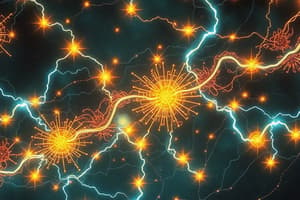Podcast
Questions and Answers
What is the study of the forces acting between charges in motion?
What is the study of the forces acting between charges in motion?
- Charged Bodies
- Electrostatics
- Electromagnetism (correct)
- Electric Current
What is the fundamental quantity of electricity?
What is the fundamental quantity of electricity?
- Electrostatics
- Electric Current
- Charge (correct)
- Electromagnetism
What is the term for a body that has the same number of electrons and protons?
What is the term for a body that has the same number of electrons and protons?
- Electrically Charged
- Neutral (correct)
- Negatively Charged
- Positively Charged
What is the process of separating charges when near an already charged object with no physical contact?
What is the process of separating charges when near an already charged object with no physical contact?
What is the subatomic particle found in the nucleus of every atom with no electrical charge?
What is the subatomic particle found in the nucleus of every atom with no electrical charge?
What type of charged body has more electrons than protons?
What type of charged body has more electrons than protons?
The study of electricity is divided into three general categories: Electrostatics, Electric ______, and Electromagnetism.
The study of electricity is divided into three general categories: Electrostatics, Electric ______, and Electromagnetism.
The ______ is the study of the forces acting between charges at rest.
The ______ is the study of the forces acting between charges at rest.
A ______ charged body has more protons than electrons in the body.
A ______ charged body has more protons than electrons in the body.
The method of charging by contact with an already charged object is called ______.
The method of charging by contact with an already charged object is called ______.
The ______ is the study of the forms of energy associated with the flow of charge.
The ______ is the study of the forms of energy associated with the flow of charge.
A ______ is a subatomic particle found in the nucleus of every atom with no electrical charge.
A ______ is a subatomic particle found in the nucleus of every atom with no electrical charge.
The presence of positive and negative charges in equal amounts in a region is referred to as ______.
The presence of positive and negative charges in equal amounts in a region is referred to as ______.
When an atom loses or gains an electron, it becomes either ______ or negatively charged.
When an atom loses or gains an electron, it becomes either ______ or negatively charged.
Flashcards are hidden until you start studying




